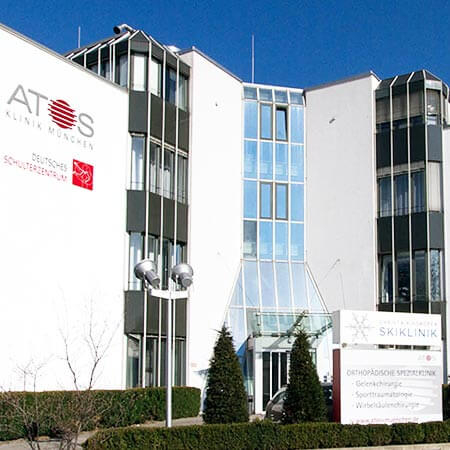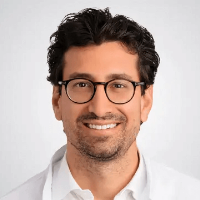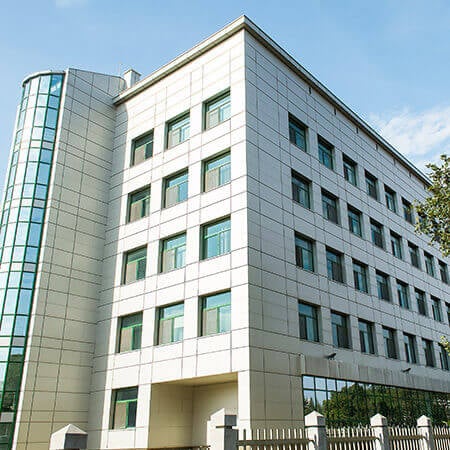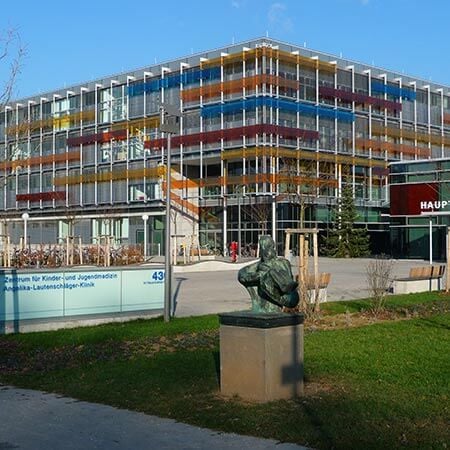Total Elbow Replacement for Elbow Arthritis treatment in Germany
Treatment prices are regulated by national law of the corresponding countries, but can also include additional hospital coefficients. In order to receive the individual cost calculation, please send us the request and medical records.
The selection of doctors and clinics is carried out on the basis of annual qualification reports. The main selection criterion is the number of operations or procedures performed. It takes into account experience, reputation in the medical society, the availability of quality certificates and high specialization in a certain field.

Department of Orthopedics, Foot Surgery, Hand Surgery and Spinal Surgery
According to the prestigious medical magazine Focus, the Department of Orthopedics, Foot Surgery, Hand Surgery and Spinal Surgery is one of the best medical facilities in Germany, specializing in shoulder and knee surgery, foot surgery, and hand surgery! The department offers a full range of medical services for diseases of the musculoskeletal system. The key focus of the department's doctors is the treatment of diseases of the large joints: knee, hip, shoulder, elbow, ankle, and wrist. Foot surgery specialists are responsible for the correction of hallux valgus, hallux rigidus, clubfoot, flatfoot, and claw toes, as well as the treatment of ankle arthrosis, heel spurs, and Achilles tendon ruptures. The department regularly admits patients with hand diseases, with particular interest in the treatment of wrist arthrosis, rhizarthrosis, carpal tunnel syndrome, and Dupuytren's contracture. The therapeutic offer is complemented by conservative and surgical treatment of spinal diseases such as herniated discs, spinal canal stenosis, vertebral fractures, and others. The department's medical team offers patients effective conservative treatment methods. However, when surgery is required, arthroscopic and minimally invasive techniques are preferred to ensure the fastest possible postoperative recovery and a high level of safety.



Department of Adult and Pediatric Orthopedics, Trauma Surgery, Foot Surgery, Hand Surgery and Rheumatology
The Department of Adult and Pediatric Orthopedics, Trauma Surgery, Foot Surgery, Hand Surgery and Rheumatology offers the full range of diagnostic and therapeutic services in its areas of specialization. The key areas of work of the department's doctors include large joint arthroplasty, arthroscopic interventions on the knee, hip, and shoulder joints, conservative and surgical treatment of foot and hand diseases and deformities, rheumatic joint lesions, orthopedic diseases in children, and musculoskeletal injuries. The key to successful clinical practice is the professionalism and unique experience of the department's medical team, combined with the advanced infrastructure and state-of-the-art equipment. The department has 5 operating rooms equipped with the latest technology. Most surgical interventions are performed using minimally invasive techniques, due to which, in the shortest possible time, the patient is verticalized, their mobility is restored, and a pronounced pain syndrome is excluded. The department annually performs more than 4,500 surgical interventions, including especially complex ones, so the specialists at the medical facility are rightfully proud of their impressive clinical experience in the surgical treatment of orthopedic diseases. Over the years, the department has gained an excellent reputation not only in Germany but also far beyond its borders.





Department of Adult and Pediatric Orthopedics, Traumatology
According to Focus magazine, the University Hospital Heidelberg ranks among the top five hospitals in Germany! The hospital is one of the most advanced and reputable medical institutions not only in Germany, but throughout Europe. There are more than 43 specialized departments and 13 medical institutes, which cover all fields of modern medicine. A distinctive feature of the hospital is the presence of unique therapeutic methods for the treatment of complex and rare clinical cases.






Severe injuries or rheumatic diseases can lead to elbow destruction. This results in chronic pain syndrome, impaired joint mobility and stability. Should other treatment options be exhausted, doctors resort to total elbow replacement. The patient's own joint is removed, and an artificial endoprosthesis is implanted instead.
Germany is one of the few countries in the world where thousands of total elbow replacement surgeries are performed every year. The treatment in this country is effective, reliable and safe for health. Germany can boast of an advanced level of medicine. The hospitals are well equipped and the orthopedic surgeons are considered among the best in the world.
You can go to one of the German hospitals for total elbow arthroplasty. The Booking Health website presents the cost of treatment in different German hospitals. We will help you find the most suitable hospital and organize your trip.
Content
- The essence of surgery
- Indications for surgery
- Replacement surgery after injuries
- Replacement surgery for rheumatoid arthritis
- How is the surgery performed?
- After surgery
- How long can an artificial elbow last?
- Why is it worth undergoing surgery in Germany?
- Treatment in Germany with Booking Health
The essence of surgery
The essence of the replacement surgery is that the doctor removes the patient's own tissues in the elbow, and places the components of the artificial endoprosthesis in their place.
The elbow joint is formed by three bones: the ulna, the radius and the humerus. As a rule, two components of the artificial joint are implanted: the ulnar and the humeral ones. Less often, a radial component may be additionally implanted. It is required in patients with rheumatoid arthritis or after severe injury with damage to the radial head.
Elbow replacement surgery is not as successful as replacement surgery for large joints in the lower extremity. However, their results have been constantly improving in recent years. Thousands of such surgical procedures are performed every year in Germany. German specialists use high-quality endoprostheses that can serve for decades.
The result of the operation is complete pain relief. Elbow stability and mobility are restored. The outcomes of surgery may deteriorate gradually. Aseptic loosening of the endoprosthesis occurs after 10-20 years. The second (revision) elbow replacement surgery is performed when the symptoms significantly worsen the patient's quality of life.
The surgery improves function of the elbow and whole upper extremity.
Cost of arthroplasty in elbow arthritis starts from €10,079. You can find other treatment prices on the Booking Health website.
Cost of arthroplasty in elbow arthritis starts from €10,079. You can find other treatment prices on the Booking Health website.
The best hospitals in Germany are:
- ATOS Clinic Munich
- University Hospital Rechts der Isar Munich
- Vitos Orthopedic Clinic Kassel
- University Hospital Frankfurt-am-Main
- University Hospital of Ludwig Maximilian University of Munich
Indications for surgery
Elbow replacement surgery is the main treatment method for injuries hopeless for osteosynthesis, their long-term consequences, rheumatoid arthritis and deforming elbow osteoarthritis. The most common indications for surgery are:
- Post-traumatic arthrosis is the most common indication (two-thirds of total elbow replacement surgeries are performed for this disease).
- Pseudarthrosis of the distal humeral epiphyseal cartilage.
- Consequences of rheumatoid arthritis.
Surgery is less often performed for other diseases:
- Primary (idiopathic) elbow osteoarthritis.
- Acute fracture.
- Bone tumors.
- Psoriatic arthritis.
- Congenital contractures.
- Dyschondroplasia.
- Syringomyelic arthropathy.
- Arthrogryposis.
- Pseudarthrosis of the proximal ulna.
Replacement surgery after injuries
Patients often develop arthrosis after traumatic elbow injuries. In addition, some recent injuries are very severe. If the doctor realizes that the restoration of the patient's own joint is unlikely, he offers the patient a total elbow replacement surgery.
The older the patient, the easier it is for the doctor to decide on the advisability for replacement surgery. At the same time, young people try to avoid such operations. This is due to the fact that even the most modern prostheses cannot function forever. Sooner or later, an operation to replace the endoprosthesis will be required.
Elbow injuries are common among young people. Approximately 25% of elbow replacement surgeries are performed before the age of 40.
The main indications are:
- Non-fused or improperly fused fractures.
- Pseudoarthrosis.
- Dislocations that lead to grade 3-4 arthrosis.
- Defect-pseudoarthrosis of the condylus humeri.
- Significant post-traumatic defects of the bones that form the elbow joint.
Elbow replacement is avoided for recent injuries. It is performed only in extreme cases, mainly in elderly patients.
Many patients are operated on after several unsuccessful attempts of conservative treatment and osteosynthesis. The replacement surgery becomes the last resort when other methods of restoring the upper limb function and relieving pain do not work.
In both young and elderly patients, even minor elbow injury can eventually lead to osteoarthritis. It progresses gradually, and after a few years it becomes severe. As a result, the patient may need to replace the elbow even long after the injury.
Replacement surgery for rheumatoid arthritis
Rheumatoid arthritis affects the elbow in 50% of patients. Moreover, in 5% of patients, this is the only focus of inflammation.
Conservative therapy is usually successful, but sometimes it does not allow the doctors to obtain a sufficient effect, and after a few years the joint is destroyed. Chronic pain and dysfunction of the upper limb forces doctors to resort to total elbow replacement.
As of today, Germany performs replacement surgery for rheumatoid arthritis less often. The decrease in the number of surgeries is caused by the improvement of conservative therapy.
In most cases, surgical interventions are performed in the long term after a traumatic elbow injury. Even minor injuries can cause severe long-term consequences. The function of the joint is gradually impaired, and stiffness or instability of the elbow may develop. The patient may also develop bone overgrowth inside, causing pain and damaging the articular cartilage. In severe cases, there is a total fusion of the articular surfaces – ankylosis (total immobility of the elbow joint).
The peculiarity of the total elbow replacement for rheumatoid arthritis is that the doctor often implants not only the humeral and ulnar, but also the radial component of the endoprosthesis. How reliable the results will be depends on the quality of medical care and the patient's health. The rate of wear and tear of the endoprosthesis is increased by a high body mass index and high levels of inflammation markers in the blood, which indicates a severe course of rheumatoid arthritis.
How is the surgery performed?
The surgery is performed under general anesthesia. The patient is placed on his stomach with his arm extended. A roller is placed under the elbow. It is also possible to use the position of the patient on the back with the hand freely lying on the chest.
The doctor makes an incision along the back of the arm. He releases the ulnar nerve and takes it on a rubber grip to avoid injury. Then the bone structures of the elbow joint are excised. The components of the endoprosthesis are implanted instead. The doctor can use both cement and cementless fixation techniques.
Some additional therapeutic manipulations may be sometimes required during replacement surgery. These include:
- Removal of bone fragments, which remained inside the joint after its traumatic injury.
- Plastic surgery of the triceps tendon in case of its tear (the tendon of the palmaris longus is used for replacement).
- Microsurgical free muscle grafting – in case of a soft tissue defect or in the presence of gross post-traumatic scars (the procedure improves elbow function, prolongs the life of the endoprosthesis and reduces the risk of infectious complications).
The doctor forms a new ulnar nerve bed. It is placed in such a way that there is no contact with either bone or metal.
After surgery
After the surgical intervention, the patient must spend several days in the hospital. On the first day, drainage can remain in his wound – a thin tube through which fluid flows. The elbow is fixed with a soft bandage.
The patient receives drug therapy. They are prescribed drugs to relieve pain. Antibiotics are used to prevent infections. In order to reduce the risk of thromboembolic complications, the patient takes anticoagulants – drugs that reduce blood clotting.
Early rehabilitation begins immediately after the intervention. The patient receives massage, physiotherapy, but elbow exercises have not yet been used. It is fixed in the position of maximum extension. The arm should remain straight for 3-5 days until the postoperative edema subsides.
When the edema is eliminated, the patient begins to work out the elbow. He performs exercises, and by the end of 2 weeks, the range of motion will achieve the maximum amplitude. By that time, soft tissues heal.
The intensity of the exercises can be increased after 2-3 weeks. Pool workouts and hydromassages are often used. According to the results of treatment and rehabilitation, most patients get rid of pain and completely restore the range of motion in the operated extremity.
How long can an artificial elbow last?
Total elbow arthroplasty becomes an increasingly common operation, especially in countries with developed medicine. Over the past 10 years, the number of primary surgical interventions performed has tripled. At the same time, the number of revision operations increased 5 times. This suggests that previously implanted endoprostheses wear out rapidly, and the doctors carry out their replacement.
In general, elbow replacement does not provide as reliable long-term results as hip or knee replacement. However, the results are constantly improving. Even now, the best endoprostheses can last for 15-20 years. Moreover, these results were obtained in patients who were operated on at the beginning of the 21st century. It is still impossible to say for sure how long the new types of endoprostheses, which are implanted today, will last. Surely, their service life will be even longer, since medical technology is constantly being improved.
Young people often suffer from elbow injuries. Many replacement surgeries are performed before the age of 40. In this case, wear and tear of the artificial joint during life is inevitable. It is not difficult to calculate at what age the second operation will be performed. If the patient was first operated on at the age of 40, then the endoprosthesis will have to be changed at about 55-60 years.
Although the lifespan of the artificial joint can be increased. For this purpose, it is necessary to control weight and avoid heavy physical exertion. Over the 20 years during which the prosthesis will maintain good functional characteristics, scientists will develop new types of artificial joints, which will be even more reliable and durable.
Revision surgery in Germany is as successful as the primary one. Even if the endoprosthesis wears out over time, it can be replaced to fully restore arm function.
Why is it worth undergoing surgery in Germany?
Replacement surgery belongs to the complex, high-tech and science-intensive areas of medicine. The results of endoprosthetics of all joints are not the same in different hospitals and different countries. The health risks also differ. Complications, successful and unsatisfactory functional treatment outcomes occur with varying frequency.
This concerns elbow replacement first of all. If large joints of the lower extremity are often replaced in any country in the world, elbow replacement is not such a common surgical procedure. It is performed much more often in developed countries than in countries with a low level of medicine. German doctors have vast experience in performing elbow replacement, have at their disposal the best equipment and the very latest types of endoprostheses. Therefore, they achieve better results in arthritis treatment.
Here are several reasons for you to undergo total elbow replacement in Germany:
- Reliable surgery outcomes.
- Treatment is safe for health, complications are very rare.
- After total elbow replacement, good and excellent results are achieved in more than 90% of patients. They feel complete pain relief and restore the function of the upper extremity.
- Only reliable endoprostheses are used, which serve for decades.
- Proper placement will extend the service life of the artificial elbow.
- Full-fledged care and rehabilitation after surgery.
- Affordable cost of treatment as compared to other developed countries.
Treatment in Germany with Booking Health
To undergo total elbow replacement in Germany, please use the Booking Health services. On our website, you can see the cost of treatment in different German hospitals, compare prices and book a medical program at an affordable price.
Please contact the Booking Health specialists to undergo treatment in Germany. Here are our benefits for you:
- We will choose the best orthopedic hospital whose doctors specialize in total elbow replacement.
- We will help you overcome the language barrier, establish communication with the German hospital and your attending physician.
- We will reduce the waiting time for the medical care program and book a doctor's appointment on the most suitable dates.
- We will reduce the price. The cost of treatment in Germany will be decreased due to the lack of additional coefficients for foreign patients.
- We will take care of all organizational issues: documents for entering the country, transfer from the airport, hotel, interpreter, etc.
- We will prepare a program and translate medical documents into German. You do not have to undergo previously performed diagnostic procedures.
- We will provide communication with the hospital upon the completion of treatment in Germany.
- We will organize additional medical examinations, treatment in Germany or rehabilitation, if necessary.
- We will buy and forward medicines to your native country.
- We will help you keep in touch with the hospital after treatment in Germany.
Booking Health makes treatment in Germany easier, faster and cheaper. We will fully organize your trip, and you will only have to focus on restoring your health.
Authors:
This article was edited by medical experts, board-certified doctors Dr. Nadezhda Ivanisova, and Dr. Bohdan Mykhalniuk. For the treatment of the conditions referred to in the article, you must consult a doctor; the information in the article is not intended for self-medication!
Our editorial policy, which details our commitment to accuracy and transparency, is available here. Click this link to review our policies.

